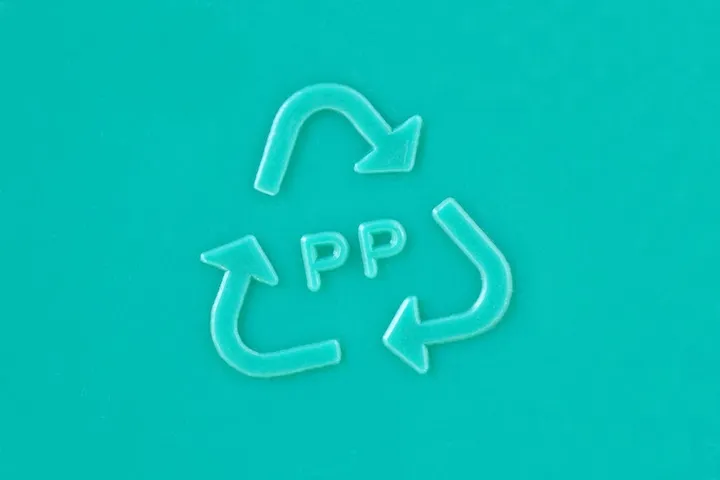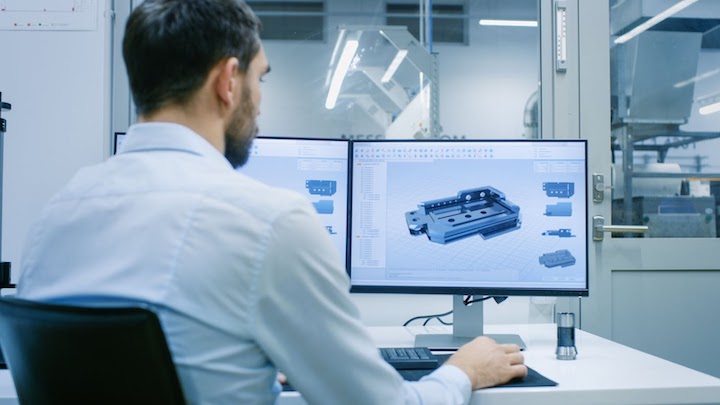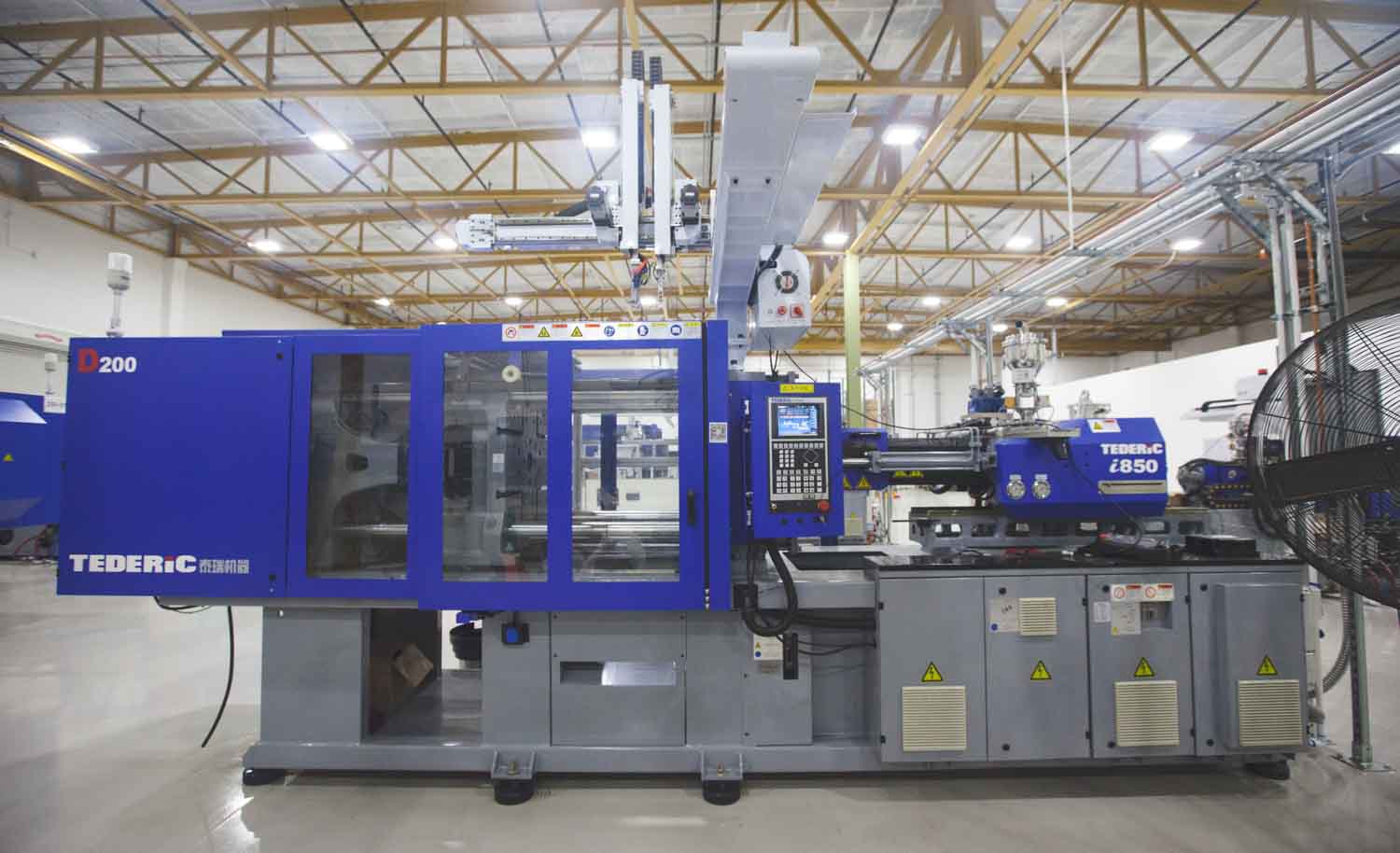Time to read: 5 min
Polypropylene is a commodity thermoplastic with a semi-crystalline structure, excellent resistance to moisture and also resists bases and some acids. In addition, polypropylene has good fatigue strength, a low coefficient of friction, and is recyclable. Polypropylene is one of the most cost-effective thermoplastics available and readily supports CNC machining and injection molding.
There are two main polypropylene variants: homopolymer and copolymer. Homopolymer polypropylene has excellent strength, stiffness, and heat deflection. Copolymer polypropylene has better impact resistance and a degree of transparency. Homopolymer polypropylene is more commonly used, but both variants have similar injection molding processing parameters.

Figure 1: Polypropylene symbol for recycling.
Advantages of Polypropylene Injection Molding
Polypropylene injection molding leverages the advantages of this material’s cost, properties, and ease of processing. For part designers, there are many other advantages as well, including:
- Low Coefficient of Friction
- Fatigue Resistance
- Low Cost
- Moisture Resistance
- Low Melt Viscosity
- Chemical Resistance
Low Coefficient of Friction
Polypropylene’s low coefficient of friction facilitates the release of injected molded parts from tooling, which helps to speed cycle times and reduce overall costs.
Fatigue Resistance
With excellent fatigue resistance, polypropylene is commonly used when a living hinge, a part feature that supports bending, is required. When properly designed, a polypropylene living hinge can withstand over a million cycles before failure, though additives will reduce polypropylene’s fatigue resistance.
Low Cost
After polyethylene, polypropylene is the most widely available commodity plastic, so is relatively inexpensive compared to other types of thermoplastics.
Moisture Resistance
Polypropylene has excellent moisture resistance and will absorb less than 0.01% water over a 24-hour period. This makes it a good choice for food and beverage packaging. Polypropylene’s moisture resistance also means that it usually does not need to be dried before injection molding — if fillers are added, however, drying may be required.
Low Melt Viscosity
Plastics with a low melt viscosity, such as polypropylene, are easier to injection mold and can fill the mold more quickly, thereby reducing cycle times and costs. Polypropylene’s low melt viscosity also makes it easier to mold thin features such as living hinges.
Chemical Resistance
Polypropylene is not as chemically resistant as polyethylene, but it still resists a wide range of chemicals, including fats, organic solvents, and some non-oxidizing acids. Polypropylene has poor resistance to chromic acid and aromatic hydrocarbons, however.

Polypropylene Injection Molding Design Guidelines
Polypropylene is relatively easy to mold, but it’s still important for part designers to follow key guidelines for some features:
- Living hinges
- Wall thickness
- Radii
- Draft angle
- Part tolerances
Download Fictiv’s injection Molding Design Guide for more tips, tricks and insights about designing for injection molding polypropylene and many other plastics.
Living Hinges
Polypropylene living hinges should have a thickness between 0.2 mm and 0.51 mm. Best practices for living hinge design include generous radii and the inclusion of “shoulders” to create a flat recess. For a deeper dive, check out our technical article on designing living hinges.
Wall Thickness
The wall thickness for injection molded polypropylene parts should, in general, be kept between 0.635 mm and 3.81 mm. In addition, transitions between thinner and thicker sections should be gradual to prevent sink marks, and ribs should be less than half the wall thickness.
Radii
In any injection molded part, radii reduce stress concentrations and increase part life. For polypropylene parts, the radius should be at least 25% of the wall thickness, and a radius of 75% of the wall thickness provides optimal properties.
Draft Angle
Polypropylene can be injection molded with a draft angle as low as one degree. Textured surfaces, however, may require a draft angle of up to five degrees depending on the nature of the texture. A draft angle of up to 10 degrees may be needed if filled polypropylene is used.
Part Tolerances
Tolerances can be either commercial or fine, with fine tolerances having tighter values — tighter tolerance requirements increase the cost of tooling and the injection molded part, however. Note that both fine and commercial tolerances vary with part size. For example, a commercial tolerance for a 20 mm polypropylene part is 0.125 mm and the fine tolerance for the same size polypropylene part is 0.075 mm.
Polypropylene Material Properties
Table 1 below lists some average physical, mechanical, and molding properties of various polypropylene injection molding grades.
| PPH | PPC | PP-Talc 30% | PP GF 30% | PP- Carbon Black-UV | ||
| Physical | Density (g/cm3) | 0.932 | 0.952 | 1.13 | 1.14 | 1.04 |
| Linear Mold Shrinkage Rate (cm/cm) | 0.0133 | 0.0128 | 0.0111 | 0.00387 | 0.0132 | |
| Rockwell Hardness (R) | 94.7 | 86.5 | 77.6 | 101 | 90.1 | |
| Mechanical | Tensile Strength at Yield (MPa) | 32.8 | 25.8 | 25.4 | 77.8 | 26.7 |
| Elongation at break (%) | 159 | 231 | 23 | 4.01 | 20.3 | |
| Flexural Modulus (GPa) | 1.44 | 1.39 | 2.6 | 5.42 | 1.92 | |
| Flexural Yield Strength (MPa) | 44.1 | 87.4 | 45.5 | 118 | 35.6 | |
| Polypropylene Injection Molding | Drying Temperature (°C) | 82.8 | 77.7 | 76.4 | 85.4 | 95 |
| Melt Temperature (°C) | 214 | 215 | 223 | 157 | 223 | |
| Mold Temperature (°C) | 41.3 | 42.9 | 49.7 | 53.1 | 53.9 | |
Table 1: Polypropylene Material Properties

Polypropylene Material Processing
Plastic injection molding with polypropylene involves choosing the right processing parameters, that these are some of the most important factors for injection molders to consider:
- Injection pressure
- Moisture resistance
- Temperature control
- Viscosity
- Shrinkage
Injection Pressure
Injection pressures should be maintained between 5.5 MPa and 10 MPa. High back pressure is not required for polypropylene and can be kept between 0.34 MPa and 0.7 MPa. It’s important to note that while higher injection pressure produces favorable results, excessively high pressures can result in the part sticking to the mold.
Moisture Resistance
Polypropylene has excellent resistance to moisture absorption. Therefore, drying before injection molding isn’t usually required, though polypropylene with certain additives may require drying, so check with the material supplier for details.
Temperature Control
Polypropylene is injection molded at temperatures between 220°C and 280°C — any temperature above 280°C can result in thermal degradation. The mold should be kept below 80°C for optimal results, and after injection, the part should cool to 54°C before ejection to prevent warping.
Viscosity
Polypropylene has a low melt viscosity, which is why it’s relatively easy to mold thin features such as living hinges. Higher injection molding temperatures will lower the viscosity, provided that the maximum temperature of 280°C is not exceeded.
Shrinkage
Polypropylene has an average shrinkage rate of between 1% and 3% — though increased wall thickness may result in higher shrinkage values. Filled polypropylene can have lower shrinkage values, depending on the fill material that is used.
Succeeding With Polypropylene Injection Molding
Polypropylene injection molding is used for a wide variety of applications, including food storage containers, parts with living hinges, and pill containers. This commonly used thermoplastic is not a particularly difficult material to injection-mold, and polypropylene is especially useful for designs that require excellent fatigue, moisture, and (a degree of) chemical resistance.
Polypropylene is a commonly used injection molding plastic, but a good plan and skilled production partner are critical to avoid the added costs and risks that come with inadequate drying or improper processing methods. Fictiv has the global manufacturing network and production experts you need to get quality injection molded parts, no matter how complex your designs. And we have the skills and know-how to support you from part design through prototyping and production.
Create your free Fictiv account and request an injection molding quote today — we mold complex parts at ridiculous speeds!










